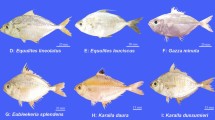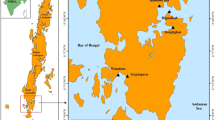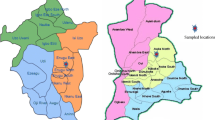Abstract
Egypt is an important geographical location for wintering puddle ducks. In order to investigate their relationships, 30 ducks from genus Anas were sampled from different aquatic regions of New Damietta, Damietta Governorate, Egypt. Many phylogenetic studies used mitochondrial cytochrome c oxidase subunit I (COI) as an effective molecular marker. The COI barcodes of six ducks species were analyzed in this work from one genus Anas belonging to family Anatidae. The studied species of ducks were identified correctly from their DNA barcodes. The distances were calculated between barcodes by utilizing of utilizing Kimura two parameter (K2P). Maximum Likelihood was used to construct a phylogenetic tree, which grouped the entire genus into three divergent clades. Within family Anatidae, COI analysis supported a basal position of Anas clypeata and Anas querquedula. It also supported the sister group relationship between Anas carolinensis and Anas platyrhynchos and the cluster comprising Anas acuta and Anas strepera. It was concluded that most Anatidae species have distinct COI sequences. DNA barcoding is a powerful molecular tool for species identification and phylogenetic inference of Anatidae.




Similar content being viewed by others
REFERENCES
Delacour, J. and Mayr, E., The family Anatidae, Wilson Bull., 1945, vol. 57, pp. 3–55.
Del Hoyo, J., Elliott, A., and Sargatal, J., Handbook of the Birds of the World, Barcelona: Lynx Editions, 1992, vol. 1.
Livezey, B.C., A phylogenetic classification of waterfowl (Aves: Anseriformes), including selected fossil species, Ann. Carnegie Mus., 1997, vol. 66, no. 4, pp. 457–496.
Livezey, B.C., Phylogenetic relationships of several subfossil Anseriformes of New Zealand, in Occasional Papers of the Museum of Natural History, Lawrence, Kan.: University of Kansas, 1989, vol. 128, pp. 1–25.
Livezey, B.C., A phylogenetic analysis of geese and swans (Anseriformes: Anserinae), including selected fossil species, Syst. Biol., 1996, vol. 45, no. 4, pp. 415–450. https://doi.org/10.1093/sysbio/45.4.415
Johnson, K.P. and Sorenson, M.D., Comparing molecular evolution in two mitochondrial protein coding genes (cytochrome b and ND2) in the dabbling ducks (Tribe: Anatini), Mol. Phylogenet. Evol., 1998, vol. 10, no. 1, pp. 82–94. https://doi.org/10.1006/mpev.1997.0481
Johnson, K.P. and Sorenson, M.D., Phylogeny and biogeography of dabbling ducks (genus: Anas): a comparison of molecular and morphological evidence, Auk, 1999, vol. 116, no. 3, pp. 792–805. https://doi.org/10.2307/4089339
Sibley, C.G. and Ahlquist, J.E., Phylogeny and Classification of Birds: A Study in Molecular Evolution, New Haven, CT: Yale University Press, 1990.
Zimmer, R., Erdtmann, B., Thomas, W.K., and Quinn, T.W., Phylogenetic analysis of the Coscoroba coscoroba using mitochondrial srRNA gene sequences, Mol. Phylogenet. Evol., 1994, vol. 3, no. 2, pp. 85–91. https://doi.org/10.1006/mpev.1994.1011
Sraml, M., Christidis, L., Easteal, S., et al., Molecular relationships within Australasian waterfowl (Anseriformes), Aust. J. Zool., 1996, vol. 44, no. 1, pp. 47–58. https://doi.org/10.1071/zo9960047
Donne-Goussé, C., Laudet, V., and Hänni, C., A molecular phylogeny of Anseriformes based on mitochondrial DNA analysis, Mol. Phylogenet. Evol., 2002, vol. 23, no. 3, pp. 339–356. https://doi.org/10.1016/s1055-7903(02)00019-2
Liu, G., Zhou, L., Zhang, L., et al., The complete mitochondrial genome of bean goose (Anser fabalis) and implications for Anseriformes taxonomy, PLoS One, 2013, vol. 8, no. 5. e63334. https://doi.org/10.1371/journal.pone.0063334
Sun, Z., Pan, T., Hu, C., et al., Rapid and recent diversification patterns in Anseriformes birds: inferred from molecular phylogeny and diversification analyses, PLoS One, 2017, vol. 12, no. 9. e0184529. https://doi.org/10.1371/journal.pone.0184529
Livezey, B.C., A phylogenetic analysis and classification of recent dabbling ducks (tribe Anatini) based on comparative morphology, Auk, 1991, vol. 108, no. 3, pp. 471–507. https://doi.org/10.2307/4088089
Kessler, L.G. and Avise, J.C., Systematic relationships among waterfowl (Anatidae) inferred from restriction endonuclease analysis of mitochondrial DNA, Syst. Biol., 1984, vol. 33, no. 4, pp. 370–380. https://doi.org/10.1093/sysbio/33.4.370
Patton, J.C. and Avise, J.C., Evolutionary genetics of birds IV rates of protein divergence in waterfowl (Anatidae), Genetica, 1986, vol. 68, pp. 129–143. https://doi.org/10.1007/BF02424410
Avise, J.C., Ankney, C.D., and Nelson, W.S., Mitochondrial gene trees and the evolutionary relationship of mallard and black ducks, Evol., 1990, vol. 44, no. 4, pp. 1109–1119. https://doi.org/10.1111/j.1558-5646.1990.tb03829.x
Tuohy, J.M., McHugh, K.P., and de Kloet, S.R., Systematic relationships among some Anatini as derived from restriction-endonuclease analysis of a repeated DNA component, Auk, 1992, vol. 109, no. 3, pp. 465–473.
Omland, K.E., Character congruence between a molecular and a morphological phylogeny for dabbling ducks (Anas), Syst. Biol., 1994, vol. 43, no. 3, pp. 369–386. https://doi.org/10.1093/sysbio/43.3.369
Omland, K.E., Examining two standard assumptions of ancestral reconstructions: repeated loss of dichromatism in dabbling ducks (Anatini), Evol., 1997, vol. 51, no. 5, pp. 1636–1646. https://doi.org/10.1111/j.1558-5646.1997.tb01486.x
Avise, J.C., Alisauskas, R.T., Nelson, W.S., and Ankney, C.D., Matriarchal population genetic structure in an avian species with female natal philopatry, Evol., 1992, vol. 46, no. 4, pp. 1084–1096. https://doi.org/10.1111/j.1558-5646.1992.tb00621.x
Zink, R.M., Rohwer, S., Andreev, A.V., and Dittmann, D.L., Trans-Beringia comparisons of mitochondrial DNA differentiation in birds, Condor, 1995, vol. 97, no. 3, pp. 639–649. https://doi.org/10.2307/1369173
Talbot, S.L. and Shields, G.F., Phylogeography of brown bears (Ursus arctos) of Alaska and paraphyly within the Ursidae, Mol. Phylogenet. Evol., 1996, vol. 5, no. 3, pp. 477–494. https://doi.org/10.1006/mpev.1996.0044
Omland, K.E. and Kondo, B.K., Phylogenetic studies of plumage evolution and speciation in New World orioles (Icterus), Acta Zool., 2006, vol. 52, pp. 320–326.
Livezey, B.C., A phylogenetic analysis of recent anseriform genera using morphological characters, Auk, 1986, vol. 103, no. 4, pp. 737–754. https://doi.org/10.1093/auk/103.4.737
Johnsgard, P.A., Hybridization in the Anatidae and its taxonomic implications, Condor, 1960, vol. 62, pp. 25–33. https://doi.org/10.2307/1365656
Rhymer, J.M. and Simberloff, D., Extinction by hybridization and introgression, Annu. Rev. Ecol. Syst., 1996, vol. 27, pp. 83–109. https://doi.org/10.1146/annurev.ecolsys.27.1.83
Tubaro, P.L. and Lijtmaer, D.A., Hybridization patterns and the evolution of reproductive isolation in ducks, Biol. J. Linn. Soc., 2002, vol. 77, no. 2, pp. 193–200. https://doi.org/10.1046/J.1095-8312.2002.00096.X
Rhymer, J.M., Williams, M.J. and Braun, M.J., Mitochondrial analysis of gene flow between New Zealand mallards (Anas platyrhynchos) and grey ducks (A. superciliosa), Auk, 1994, vol. 111, no. 4, pp. 970–978. https://doi.org/10.2307/4088829
Kulikova, I.V., Zhuravlev, Y.N. and McCracken, K.G., Asymmetric hybridization and sex-biased gene flow between eastern spot-billed ducks (Anas zonorhyncha) and mallards (A. platyrhynchos) in the Russian Far East, Auk, 2004, vol, 121, no. 3, pp. 930–949. https://doi.org/10.1642/0004-8038(2004)121[0930:AH-ASGF]2.0.CO;2
Lanyon, S.M., Phylogenetic frameworks: towards a firmer foundation for the comparative approach, Biol. J. Linn. Soc., 1993, vol. 49, no. 1, pp. 45–61. https://doi.org/10.1111/j.1095-8312.1993.tb00684.x
Baker, A.J. and Marshall, H.D., Mitochondrial control region sequences as tools for understanding evolution, in Avian Molecular Evolution and Systematics, Midell, D.P., Ed., San Diego: Academic, 1997, p. 51–82.
Mindell, D.P., Sorenson, M.D., Huddleston, C.J., et al., Phylogenetic relationships among and within select avian orders based on mitochondrial DNA, in Avian Molecular Evolution and Systematics, Midell, D.P., Ed., San Diego: Academic, 1997, p. 211–247.
Moore, W.S. and Defilippis, V.R., The window of taxonomic resolution for phylogenies based on mitochondrial cytochrome b, in Avian Molecular Evolution and Systematics, Midell, D.P., Ed., San Diego: Academic, 1997, pp. 84–119.
Delport, W., Ferguson, J.W.H., and Bloomer, P., Characterization and evolution of the mitochondrial DNA control region in hornbills (Bucerotiformes), J. Mol. Evol., 2002, vol. 54, no. 6, pp. 794–806. https://doi.org/10.1007/s00239-001-0083-0
Aquadro, C.F. and Greenberg, B.D., Human mitochondrial DNA variation and evolution: analysis of nucleotide sequences from seven individuals, Genetics, 1983, vol. 103, no. 2, pp. 287–312.
Lansman, R.A., Avise, J.C. and Huettel, M.D., Critical experimental test of the possibility of “paternal leakage” of mitochondrial DNA, Proc. Natl. Acad. Sci. USA., 1983, vol. 80, no. 7, pp. 1969–1971. https://doi.org/10.1073/pnas.80.7.1969
Cann, R.L., Brown, W.M., and Wilson, A.C., Polymorphic sites and the mechanism of evolution in human mitochondrial DNA, Genetics, 1984, vol. 106, no. 3, pp. 479–499.
Hebert, P.D., Cywinska, A., Ball, S.L., et al., Biological identifications through DNA barcodes, Proc. Biol. Sci., 2003, vol. 270, no. 1512, pp. 313–321. https://doi.org/10.1098/rspb.2002.2218
Hebert, P.D., Ratnasingham, S., and deWaard, J.R., Barcoding animal life: cytochrome c oxidase subunit 1 divergences among closely related species, Proc. Biol. Sci., 2003, vol. 270, no. 1, pp. S96–S99. https://doi.org/10.1098/rsbl.2003.0025
Hebert, P.D., Stoeckle, M.Y., Zemlak, T.S., and Francis, C.M., Identification of birds through DNA barcodes, PLoS Biol., 2004, vol. 2, no. 10, p. e312. https://doi.org/10.1371/journal.pbio.0020312
Cai, Y., Yue, B., Jiang, W., et al., DNA barcoding on subsets of three families in Aves, Mitochondrial DNA, 2010, vol. 21, nos. 3–4, pp. 132–137. https://doi.org/10.3109/19401736.2010.494726
Breman, F.C., Jordaens, K., Sonet, G., et al., DNA barcoding and evolutionary relationships in Accipiter Brisson, 1760 (Aves, Falconiformes: Accipitridae) with a focus on African and Eurasian representatives, J. Ornithol., 2013, vol. 154, pp. 265–287. https://doi.org/10.1007/s10336-012-0892-5
Kerr, K.C.R., Stoeckle, M.Y., Dove, C.J., et al., Comprehensive DNA barcode coverage of North American birds, Mol. Ecol. Notes, 2007, vol. 7, no. 4, pp. 535–543. https://doi.org/10.1111/j.1471-8286.2007.01670.x
Johnsen, A., Rindal, E., Ericson, P.G.P., et al., DNA barcoding of Scandinavian birds reveals divergent lineages in trans-Atlantic species, J. Ornithol., 2010, vol, 151, no. 3, pp. 565–578. https://doi.org/10.1007/s10336-009-0490-3
Tamura, K., Peterson, D., Peterson, N., et al., MEGA5: molecular evolutionary genetics analysis using maximum likelihood, evolutionary distance, and maximum parsimony methods, Mol. Biol. Evol., 2011, vol. 28, no. 10, pp. 2731–2739. https://doi.org/10.1093/molbev/msr121
Olson, S.L. and Feduccia, A., Presbyornis and the origin of the Anseriformes (Aves: Charadriomorphae), Smithson. Contrib. Zool., 1980, vol. 323, pp. 1–24. https://doi.org/10.5479/si.00810282.323
Olson, S.L., The fossil record of birds, in Avian Biology, Farner, D.S., Ed., Orlando: Academic Press, 1985, pp. 79–238.
Lee, W.S., Koo, T.H., and Park. J.Y., A Field Guide to the Birds of Korea, LG Evergreen Foundation, Korea, 2000.
Avise, J.C., Arnold, J., Ball, R.M., et al., Intraspecific phylogeography: the mitochondrial DNA bridge between population genetics and systematics, Annu. Rev. Ecol. Syst., 1987, vol. 18, pp. 489–522. https://doi.org/10.1146/annurev.es.18.110187.002421
Moritz, C., Dowling, T.E., and Brown, W.M., Evolution of animal mitochondrial DNA: relevance for population biology and systematics, Annu. Rev. Ecol. Syst., 1987, vol. 18, pp. 269–292. https://doi.org/10.1146/annurev.es.18.110187.001413
Moore, W.S., Inferring phylogenies from mtDNA variation: mitochondrial-gene trees versus nuclear-gene trees, Evol., 1995, vol. 49, no. 4, pp. 718–726. https://doi.org/10.1111/j.1558-5646.1995.tb02308.x
Avise, J.C., Phylogeography: The History and Formation of Species, Cambridge: Harvard University Press, 2000.
Palumbi, S.R., Cipriano, F., and Hare, M.P., Predicting nuclear gene coalescence from mitochondrial data: the three-times rule, Evol., 2001, vol. 55, no. 5, pp. 859–868. https://doi.org/10.1111/j.0014-3820.2001.tb00603.x
Funk, D.J. and Omland, K.E., Species-level paraphyly and polyphyly: frequency, causes, and consequences, with insights from animal mitochondrial DNA, Annu. Rev. Ecol. Evol. Syst., 2003, vol. 34, pp. 397–423. https://doi.org/10.1146/annurev.ecolsys.34.011802.132421
Ballard, J.W.O. and Whitlock, M.C., The incomplete natural history of mitochondria, Mol. Ecol., 2004, vol. 13, no. 4, pp. 729–744. https://doi.org/10.1046/j.1365-294x.2003.02063.x
Kusumaningrum, H.P., Haryanti, W.D.U., and Rahayu, A.R., Phylogenetic analysis of duck species from tegal Indonesia using 18S ribosomal RNA and mitochondrial COI gene, Int. J. Poult. Sci., 2018, vol. 17, pp. 392–404. https://doi.org/10.3923/ijps.2018.392.404
Funding
This study was funded by the author.
Author information
Authors and Affiliations
Corresponding author
Ethics declarations
Conflict of interest. The author declares that no conflict of interest.
Statement on the welfare of animals. All applicable international, national, and/or institutional principles for the care and use of animals were observed.
Rights and permissions
About this article
Cite this article
Deef, L.E. Phylogenetic Relationships among Puddle Duck Species in Egypt using COI Gene Variations in mtDNA. Russ J Genet 57, 1189–1197 (2021). https://doi.org/10.1134/S1022795421100045
Received:
Revised:
Accepted:
Published:
Issue Date:
DOI: https://doi.org/10.1134/S1022795421100045




